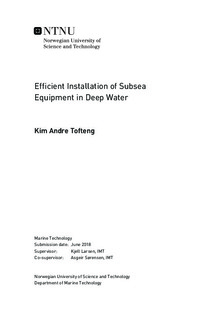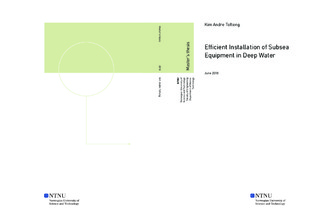| dc.description.abstract | This thesis presents methods to preform subsea equipment installations, and highlights problems related to the conventional crane operation used in marine operations. The crane operation faces many challenges at water depths close to 3000 m, and several recent developed methods to preform deepwater installations more e cient are presented and briefly discussed.
An autonomous method to complete a subsea equipment installation is presented and explored in the thesis. Using active control of actuators attached to the installation object, the object can be launched into the water from the support vessel, and positioned in the desired installation position by a control system. Equipment proposals for control actuators are made, and a mathematical model to control the motions of an installation object is presented in the thesis.
Several case studies are preformed on a deepwater installation of an integrated template and mani- fold structure (ITS), using the autonomous installation method. The control systems behaviour in di↵erent current conditions and control actuator requirements are assessed. Methods using active control together with an attached buoyancy tank or parachute are also simulated and assessed.
Based on the simulated cases, it s concluded that the presented installation method is feasible. The sensor equipment required by the control system to control the motions and postion of the installation object already exists, and are commonly used on underwater robots. A minimum of 200 [kN] is required from the control actuators in surge and sway, when the structure is submerged in 1 m/s currents, to position the a 260 tonne ITS structure in the horizontal plane, which can be produced by large attached thrusters. The roll and pitch rotations of the ITS structure is considered unfeasible to control by actuators, and the structure must therefore be stabilized passively by a buoyancy tank, parachute or some other component. Passive methods to reduce the drop velocity of the structure in water, by increasing drag damping or buoyancy is also necessary. | |

